by Prisca Martens, Towson University, Towson, MD
This week I’ll provide an example of the kinds of curricular experiences my co-researchers and I designed for the first graders to help them learn to read the pictorial text in picturebooks. As I shared last week, at the end of the school year most of the children were making sophisticated observations and reading meanings in the illustrations, in addition to the written text, which enhanced their understandings.
 Before the study began, we decided to primarily limit our focus during the year to helping the first graders begin to understand the art elements of line, color, and shape and the principle of movement. The first picturebook we studied with the children was Guji Guji (Chen, 2004), the story of a young crocodile who is raised in a family of ducks. The pictorial text provides rich opportunities to discuss the use of warm/cool colors, diagonal lines, and pointed/rounded edges to indicate good/bad characters. Stacy, the art teacher, introduced the book in art class before the first grade teachers, Jenna and Michelle, read and discussed it in their classrooms. Stacy went through the illustrations with the children, helping them read the meanings Chen had represented.
Before the study began, we decided to primarily limit our focus during the year to helping the first graders begin to understand the art elements of line, color, and shape and the principle of movement. The first picturebook we studied with the children was Guji Guji (Chen, 2004), the story of a young crocodile who is raised in a family of ducks. The pictorial text provides rich opportunities to discuss the use of warm/cool colors, diagonal lines, and pointed/rounded edges to indicate good/bad characters. Stacy, the art teacher, introduced the book in art class before the first grade teachers, Jenna and Michelle, read and discussed it in their classrooms. Stacy went through the illustrations with the children, helping them read the meanings Chen had represented.  They talked about, for example, how Chen drew the bad crocodiles with angle lines (i.e., pointed teeth, pointed eyes, sharp claws) and blue (cool color) noses and Guji Guji with more curved lines and an orange (warm color) nose to show he was good. After reading the pictorial text, Stacy asked the children to draw two of the same animals in their sketchbooks, showing one as good using curvy lines and the other as bad, using angle lines.
They talked about, for example, how Chen drew the bad crocodiles with angle lines (i.e., pointed teeth, pointed eyes, sharp claws) and blue (cool color) noses and Guji Guji with more curved lines and an orange (warm color) nose to show he was good. After reading the pictorial text, Stacy asked the children to draw two of the same animals in their sketchbooks, showing one as good using curvy lines and the other as bad, using angle lines.
We knew the children all enjoyed I Love My New Toy (Willems, 2008) and decided to use that book with the children next. After rereading the book, we asked the children what they noticed about how Willems used the pictorial text to convey meanings and how that did/did not match meanings in the written text. Since Piggie’s emotions change several times during the story, we invited the children to generate lists on chart paper of the ways Willems represented these emotions through the art in the pictorial text, particularly looking at how we could “read” Piggie to know how she was feeling. The lists in included, for example:
- repeated heart shapes above her head and her over-sized oval eyes to show her happiness;
- diagonal eyebrows and short repeated parallel lines to show the movement of her fist and arms to indicate she was angry;
- the use of extra color on her cheek and repeated lines surrounding her head to show her embarrassment;
- and large eyes triangular marks surrounding her head to show she was happy again.
We also asked the children to talk about what they did on the double page spreads with only pictorial text (i.e., whether or not there was something to read), using that as an opportunity to explore the notion that art, like written language, is text to read, rather than merely pictures to accompany the story.
The children’s enthusiasm lead to an author/illustrator study of Mo Willems. We referred to the lists and continued to look for and discuss how Willems represented meaning through his art and how that related to the written text. Stacy provided opportunities for the children to practice some of Willems’ techniques in art and the children sometimes wrote stories in their classrooms. The children began to understand that the written text alone does not have the meaning embedded in the pictorial text.
We followed this same procedure with a number of other books and next week I’ll share some of those and the art concepts, techniques, and experiences we highlighted in them.
Journey through Worlds of Words during our open reading hours: Monday-Friday, 9 a.m. to 5 p.m. and Saturday, 9 a.m. to 1 p.m. To view our complete offerings of WOW Currents, please visit archival stream.
- Themes: pictorial text, Prisca Martens
- Descriptors: Books & Resources, Debates & Trends, Student Connections, WOW Currents

I enjoyed this article because in my art class on Friday my teacher taught us about the drawings in Guji Guji. The drawings were very helpful because of the angles, colors and shapes. And like you stated it would be very helpful for kids who are beginning to learn about art.
I love the aspect that all classes can become involved in the books our children love. It is awesome how the children can understand the illustrations so well and read into them.